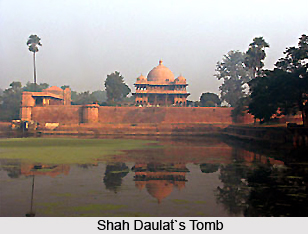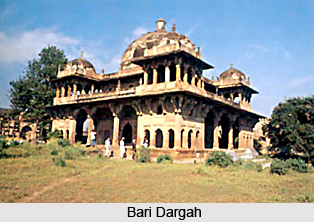 Monuments in Maner include one of the finest Mughal monuments in eastern India, the Choti Dargah or Tomb of Shah Daulat. Located on the banks of the River Ganges, the beautiful city of Maner in Patna district is at a distance of twenty nine kilometers to the east of Patna. This city in Bihar was once situated on the union of the Son and the River Ganga. The city of Maner used to form the western gate of Pataliputra, which is now called Patna, in the period of the Mauryan Empire. The work of excavation undertaken at this place unearthed some of the remains of an old fort which significantly implies to the existence of the palace.
Monuments in Maner include one of the finest Mughal monuments in eastern India, the Choti Dargah or Tomb of Shah Daulat. Located on the banks of the River Ganges, the beautiful city of Maner in Patna district is at a distance of twenty nine kilometers to the east of Patna. This city in Bihar was once situated on the union of the Son and the River Ganga. The city of Maner used to form the western gate of Pataliputra, which is now called Patna, in the period of the Mauryan Empire. The work of excavation undertaken at this place unearthed some of the remains of an old fort which significantly implies to the existence of the palace.
The notable among the Maner monuments include the mausoleum belonging to the great thirteenth century Sufi Saint called Hazrat Makhdoom Yahiya Maner and Shah Daulat`s tomb, who was the disciple of the Sufi Saint. At the time of Urs festival, huge numbers of devotees belonging to the Muslim community visit this holy place. There is belief that the city of Maner has got its name from the famous Sufi Saint.
 The small and wonderful city of Maner is to the west of Patna on the road to Arrah. An ancient strategic point, it may well have been the extreme western gate to Pataliputra in Mauryan times. It was here at Maner that Islam first made an impact in Bihar, in the year 1198. There are two fine Muslim tombs. The Choti Dargah or Tomb of Shah Daulat, constructed by Ibrahim Khan, is the finest Mughal monument in eastern India, with delicate carvings and surface ornament. It is situated on a raised platform with slender corner towers and crowned by a huge dome. Internally, the ceiling is covered with Quranic inscriptions. Within the compound is a mosque erected by Ibrahim Khan in the year 1619. The gateway to the north is also distinguished.
The small and wonderful city of Maner is to the west of Patna on the road to Arrah. An ancient strategic point, it may well have been the extreme western gate to Pataliputra in Mauryan times. It was here at Maner that Islam first made an impact in Bihar, in the year 1198. There are two fine Muslim tombs. The Choti Dargah or Tomb of Shah Daulat, constructed by Ibrahim Khan, is the finest Mughal monument in eastern India, with delicate carvings and surface ornament. It is situated on a raised platform with slender corner towers and crowned by a huge dome. Internally, the ceiling is covered with Quranic inscriptions. Within the compound is a mosque erected by Ibrahim Khan in the year 1619. The gateway to the north is also distinguished.
The Bari Dargah or Tomb of Yahia Maneri is situated in a mosque to the east of a large tank with porticos and ghats extending into it. The tank is connected to the old course of the Son River by a one hundred and twenty two meter long tunnel. The tomb lies in an old tree-lined enclosure. To the north is a three-domed mosque, to the west, quaint cloisters built by Ibrahim Khan in 1605-6. Although architecturally far less remarkable than the Choti Dargah, the Bari Dargah has been a place of pilgrimage for centuries. Emperor Babur came here in 1529. The Tomb of Tingur Kuli Khan is situated on the bank of a tank, where the stone inscriptions remain.



















